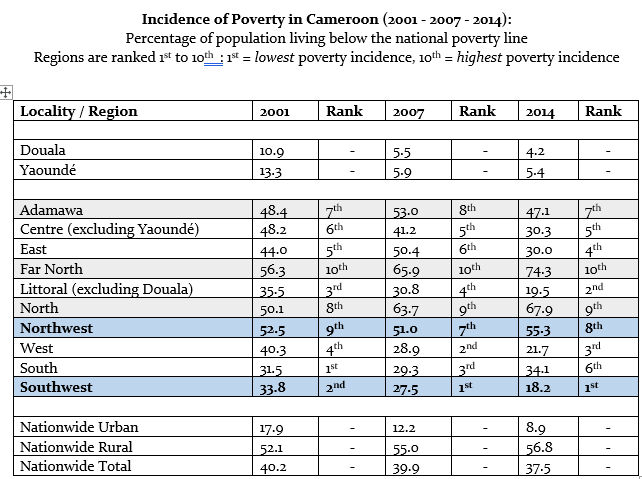What was the objective socio-economic situation of the NW and SW regions before the onset of the crisis in 2016? Did these regions rank much worse in development indicators, compared to other regions of the country?
Data Source: Cameroon National Institute of Statistics:
- 2nd National Household Survey, 2001 (Main Report, pp. 34)
- 3rd National Household Survey, 2007 (Main Report, pp. 18)
- 4th National Household Survey, 2014 (Evolution of Principal Indicators, pp. 2)

Data Explanation:
It should be pointed out from the outset that the incidence of poverty cannot, on its own, be used as an indicator to depict the entire socio-economic situation of a given region, nor variations between regions.
In Cameroon, the incidence of monetary poverty is determined through statistical methods as part of periodic National Household Surveys (NHS). Monetary poverty is an indicator which enables the determination of the number of citizens or residents of the country who are capable or incapable of affording a basket of consumer goods (both food and non-food consumption goods), which basket constitutes the national poverty level. For instance, for the 4th National Household Survey (NHS) conducted in 2014, this basket of consumer goods (poverty level) was evaluated at 28,31o frs CFA/month, or 931 francs CFA/day. Through tracking actual spending by households on consumption of different goods (including evaluating consumption by rural households of their home-grown crops, or the rental costs offset for households who own their own home), these surveys make it possible to determine the number of inhabitants who are living above, and those living below, the “minimum basket of consumption goods” (which is the poverty level).
Additionally, the incidence of poverty does not directly measure other facets of development in a given region, such as the quality of infrastructure (e.g. all-season paved roads), or tele-density. However, the trend analysis that accompanies the National Household Surveys points in the direction of a strong correlation between the incidence of poverty and other development facets, such as: degree of urbanization (whether the household lives in an urban or rural area), the level of education of its income-earner(s), the size of the household, whether its breadwinners work in the formal or informal sector, access to infrastructure, etc. The incidence of poverty is however not a mere “aggregated value” of the economic productivity (wealth) of a region, divided by the number of its inhabitants (such as is provided by GDP per capita) – for it tracks actual consumption by a statistically-relevant sample of the population under examination.
From this data, it can be seen that (in 2014, and for the 15 preceding years) the NW and SW regions found themselves in quite diametrically opposed socio-economic conditions. In the period from 2000 to 2015, the SW region was systematically in the leading pack of regions of Cameroon least beset by poverty, having been ranked 2nd nationwide in 2001, 1st in 2007, and 1st in 2014. It is in fact the region of Cameroon that consistently showed the lowest poverty incidence rates. By contrast, during the same period, the NW region was ranked respectively 9th (2001), 7th (2007), and 8th (2014), placing it consistently among the least-performing regions in terms of poverty alleviation. While the percentage of the SW region’s population living below the poverty line reduced by half between 2001 and 2014 (33,8% to 18.2 %), the NW region’s population living below the poverty line increased during the same period (from 52.5% to 55.3%). This tends to confirm that before the onset of the crisis, an unfavourable economic situation was not a key trait that these two regions had in common.